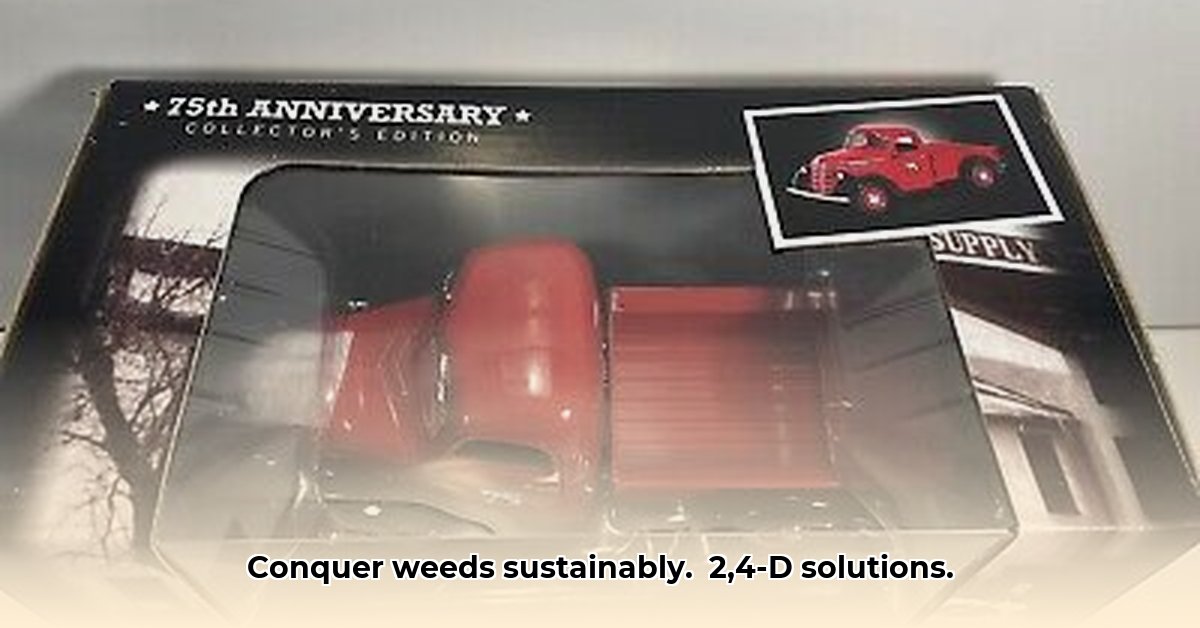
This guide provides actionable, technical information on the responsible use of 2,4-D herbicide, readily available at Tractor Supply, within the context of sustainable agriculture. We'll explore its application, environmental impact, and alternatives, emphasizing Integrated Pest Management (IPM) strategies. For larger applications, consider a larger sprayer.
Understanding 2,4-D Herbicide
2,4-D (2,4-Dichlorophenoxyacetic acid) is a selective herbicide (a weed killer that targets specific plants). It primarily affects broadleaf weeds (weeds with wide, flat leaves), leaving many grasses unharmed. This selectivity makes it useful in agricultural settings, but responsible application is critical. Various formulations exist, including esters and salts, each with differing volatility and environmental impacts. Improper use can lead to unintended harm to non-target plants or the environment.
Safe and Effective Application of 2,4-D
Successful and responsible 2,4-D application hinges on precise steps and careful adherence to product label instructions. Always prioritize safety.
Step 1: Pre-Application Assessment
Before mixing or spraying, carefully identify target weeds and any nearby non-target plants or environmentally sensitive areas. This evaluation guides your choice of 2,4-D formulation and application method. Improper identification might result in unintended harm.
Step 2: Mixing the Solution
Accurately measure and mix the 2,4-D solution according to the label instructions. Using incorrect proportions can compromise efficacy or cause damage. Always use the recommended amount of water.
Step 3: Application Timing and Technique
Apply 2,4-D when weeds are actively growing and weather conditions are favorable (calm, warm days, and low chances of precipitation within 24 hours). Use appropriate application equipment (sprayers, granular applicators) calibrated correctly to ensure even distribution. Incorrect application can lead to uneven results, harming non-target plants.
Step 4: Personal Protective Equipment (PPE)
Always wear appropriate PPE, including gloves, eye protection, and long-sleeved clothing during mixing and application to protect yourself from potential harm.
Environmental Considerations
While 2,4-D is selective, irresponsible use can harm non-target organisms and pollute water sources. Minimizing environmental impact requires careful planning and implementation.
- Buffer Zones: Maintain sufficient buffer zones (areas of untreated land) around water bodies to prevent herbicide runoff.
- Targeted Application: Minimize spraying to only the areas requiring treatment. Precision application is key to preventing contamination.
- Soil Conservation: Employ soil conservation practices (e.g., no-till farming) to reduce herbicide leaching into groundwater.
- Weather Conditions: Avoid applying during windy conditions or when rain is expected. Knowing the weather forecast is essential.
Integrated Pest Management (IPM) Strategies
IPM emphasizes a holistic approach, minimizing the need for chemical herbicides through a combination of strategies. Implementing these practices reduces reliance on 2,4-D and minimizes environmental impact.
- Cultural Controls: Employ practices like crop rotation, proper soil fertility management, and using weed-free seeds to help reduce weed growth.
- Biological Controls: Utilize beneficial insects or microorganisms to naturally suppress weed populations.
- Mechanical Controls: Incorporate mechanical methods such as tillage, mowing, or hand weeding, as appropriate.
Sustainable Alternatives to 2,4-D
Several sustainable alternatives are available, reducing or eliminating dependence on chemical herbicides.
- Mechanical Weed Control: Tilling, hoeing or mowing effectively remove weeds, but depending on the scale of your operation, this can be labor-intensive.
- Cover Cropping: Planting cover crops ahead of cash crops can suppress weed growth and improve soil health.
- Crop Rotation: Rotating crops disrupts weed life cycles, reducing weed pressure.
Proper Disposal and Handling of 2,4-D
Always handle, store, and dispose of 2,4-D and its containers according to the product label instructions and local regulations. Never pour unused herbicide down the drain or into waterways.
Conclusion: Responsible Herbicide Use in Sustainable Agriculture
Integrating 2,4-D responsibly within a broader IPM strategy is key to sustainable agriculture. Always prioritize careful planning, precise application, and adherence to label instructions. By doing so, you can effectively manage weeds while minimizing environmental impact. Remember to explore sustainable alternatives and practices to further reduce your dependence on chemical herbicides.